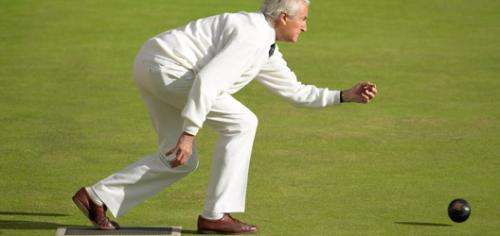Inaccessible leisure facilities are a barrier to fitness, fun and independence for older people with sight loss

Researchers from Loughborough University have been involved in a ground-breaking research project looking at how older people with sight loss can engage in physical activity.
The findings of the study were released today (25 June) by sight loss charity Thomas Pocklington Trust, who called on leisure providers to make facilities and activities accessible and sight-loss friendly.
Speaking at the first national conference on physical activity for older people, Dr Catherine Dennison, Head of Health and Wellbeing Research at the Thomas Pocklington Trust, said: "This is the first time systematic research has asked older people with sight loss about their experience of trying to stay active.
"Many of the participants enjoyed walking, cycling, bowls or dance, for example, but all of them had suffered problems with accessibility. They want to stay fit, mobile and independent but the research shows that they are unfairly disadvantaged.
"A determined effort is needed by all those providing physical activities to make them accessible to all."
The study, Physical Activity among Older People with Sight Loss, carried out by researchers at the University of Exeter Medical School and Loughborough University, interviewed older people with sight loss about their experiences of trying to stay active.
All the participants felt a deep sense of loss at having to reduce their physical activity because of sight loss. They were well aware of the important benefits of staying mobile but cited numerous barriers that excluded them. While health was a key factor, the lack of accessible facilities was a major block to them pursuing what they wanted – fitness, fun, social interaction and independence.
Dr Brett Smith, from Loughborough University's School of Sport, Exercise and Health Sciences, said: "Not enough people are active and this comes at a cost to their health and wellbeing as well as to the NHS. Yet, despite changes in the anti-discrimination law, gyms and other spaces to be active in are often inaccessible."
Now Pocklington has called on leisure providers, local authorities and county sports partnerships to provide activities that are both sustainable and accessible for older people with sight loss.
"Ever since the Olympic Games there has been a real buzz about the importance of staying active, particularly for older people, but sight loss is also common in old age and providers of all physical activities need to factor that into their facilities and the type of activities they offer," said Dr Dennison.
No previous systematic research has been carried out concerning physical activity among older people with sight loss, and health and fitness policy has had little to say about this group. In general, the Government recommends that adults should take 30 minutes of physical activity five times a week. This recommendation is just as important for older adults with sight loss as their sighted peers. Yet little appears to have been done to find out how to help older people with sight loss engage with physical activity and what advice will directly answer the specific problems they face.
The Pocklington study is the first to try and address this question. Forty-eight people with sight loss aged 60 and over were interviewed – some with 'mobile interviews' where researchers took part in activities alongside the interviewees. Some participants kept audio diaries.
The study found that:
- Two main factors influence the involvement of older people with sight loss in physical activity: their level of general health and mobility – many older people are coping with multiple health problems – and whether activities are both regularly available and easy to access.
- Those taking part in physical activity stressed important rewards – physical, mental and emotional, including social interaction and immense pleasure.
- They relied on social support, accessible transport and good information to be able to take part.
- Barriers, on the other hand, including health issues, transport difficulties, cost, lack of variety and sustainability of activities, and lack of social support prevented many from taking part. Many also had fears about safety or were low in confidence.
- Leisure facilities were often inaccessible and could be unwelcoming to people with sight loss. Better signage, good lighting and the removal of potential obstacles, both inside and outside of the building, could make them more accessible.
- The interests and needs of older people with sight loss vary enormously so the range of opportunities to participate in physical activities needs expanding to offer a wide variety of choice.
- With the number of older adults living with sight loss growing, visual impairment should be incorporated into the larger ageing agenda to improve awareness generally of sight loss in older age.
More information: The research, Physical Activity among Older People with Sight Loss, was carried out by Cassandra Phoenix and Meridith Griffin, University of Exeter Medical School, and Brett Smith and P. David Howe, Loughborough University. The full report is available online: lboro.ac.uk/media/wwwlboroacuk … s/resources/Physical%20Activity%20among%20Older%20People%20with%20Sight%20Loss%20.pdf

















